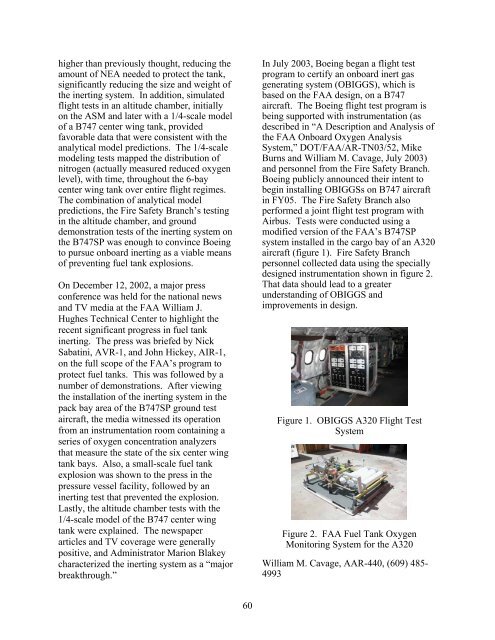AAR-400 Highlights 2002 - Fire Safety Branch - FAA
AAR-400 Highlights 2002 - Fire Safety Branch - FAA
AAR-400 Highlights 2002 - Fire Safety Branch - FAA
You also want an ePaper? Increase the reach of your titles
YUMPU automatically turns print PDFs into web optimized ePapers that Google loves.
higher than previously thought, reducing the<br />
amount of NEA needed to protect the tank,<br />
significantly reducing the size and weight of<br />
the inerting system. In addition, simulated<br />
flight tests in an altitude chamber, initially<br />
on the ASM and later with a 1/4-scale model<br />
of a B747 center wing tank, provided<br />
favorable data that were consistent with the<br />
analytical model predictions. The 1/4-scale<br />
modeling<br />
tests mapped the distribution of<br />
nitrogen (actually measured reduced oxygen<br />
level),<br />
with time, throughout the 6-bay<br />
center<br />
wing tank over entire flight regimes.<br />
The combination of analytical model<br />
predictions, the <strong>Fire</strong> <strong>Safety</strong> <strong>Branch</strong>’s testing<br />
in the altitude chamber, and ground<br />
demonstration tests of the inerting system on<br />
the B747SP was enough to convince Boeing<br />
to pursue onboard inerting as a viable means<br />
of preventing fuel tank explosions.<br />
On December 12, <strong>2002</strong>, a major<br />
press<br />
conference<br />
was held for the national news<br />
and TV media at the <strong>FAA</strong> William J.<br />
Hughes Technical Center to highlight the<br />
recent significant progress in fuel tank<br />
inerting. The press was briefed by Nick<br />
Sabatini, AVR-1, and John Hickey, AIR-1,<br />
on the full scope of the <strong>FAA</strong>’s program to<br />
protect fuel tanks. This was followed by a<br />
number of demonstrations. After viewing<br />
the installation of the inerting system<br />
in the<br />
pack bay area of the B747SP ground test<br />
aircraft, the media witnessed its operation<br />
from an instrumentation room containing a<br />
series of oxygen concentration analyzers<br />
that measure the state of the six center<br />
wing<br />
tank<br />
bays. Also, a small-scale fuel tank<br />
explosion was shown to the press in the<br />
pressure vessel facility, followed by an<br />
inerting test that prevented the explosion.<br />
Lastly, the altitude chamber tests with the<br />
1/4-scale model of the B747 center wing<br />
tank were explained. The newspaper<br />
articles and TV coverage were generally<br />
positive, and Administrator Marion Blakey<br />
characterized the inerting system as a “major<br />
breakthrough.”<br />
60<br />
In July 2003, Boeing began a flight test<br />
program to certify an onboard inert gas<br />
generating system<br />
(OBIGGS), which is<br />
based<br />
on the <strong>FAA</strong> design, on a B747<br />
aircraft. The Boeing flight test program is<br />
being supported with instrumentation (as<br />
described in “A Description and Analysis<br />
of<br />
the <strong>FAA</strong> Onboard Oxygen Analysis<br />
System,” DOT/<strong>FAA</strong>/AR-TN03/52, Mike<br />
Burns and William M. Cavage, July 2003)<br />
and personnel from the <strong>Fire</strong> <strong>Safety</strong> <strong>Branch</strong>.<br />
Boeing publicly announced their intent to<br />
begin installing OBIGGSs on B747 aircraft<br />
in FY05. The <strong>Fire</strong> <strong>Safety</strong> <strong>Branch</strong> also<br />
performed a joint flight<br />
test program with<br />
Airbus. Tests were conducted using a<br />
modified version of the <strong>FAA</strong>’s B747SP<br />
system installed in the cargo bay of an A320<br />
aircraft (figure 1). <strong>Fire</strong> <strong>Safety</strong> <strong>Branch</strong><br />
personnel collected data using the specially<br />
designed instrumentation shown in figure 2.<br />
That data should lead to a greater<br />
understanding of OBIGGS and<br />
improvements in design.<br />
Figure 1. OBIGGS A320 Flight Test<br />
System<br />
Figure 2. <strong>FAA</strong> Fuel Tank Oxygen<br />
Monitoring System for the A320<br />
William M. Cavage, <strong>AAR</strong>-440, (609) 485-<br />
4993
















